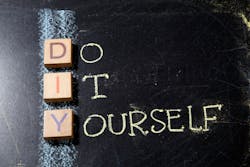In the midst of concerns about direct-to-consumer orthodontics, there is another do-it-yourself fad that deserves our attention: sleep appliances. A myriad of mandibular advancement appliances designed to treat sleep-related breathing disorders have flooded the market during the past few years. Dentists have their work cut out for them deciding which appliance they believe will best treat their patients’ conditions. However, there have also been a number of direct-to-consumer appliances that customers can order online or purchase in a local pharmacy. These are sometimes affectionately referred to as the “boil-and-bite” category.
There are some procedures patients can do for themselves (e.g., non-prescription-strength whitening), and there are some procedures that are best left to trained professionals. Fortunately, there aren’t any DIY tooth extraction kits being sold in stores, and I don’t foresee that happening anytime soon. That’s because the dangers of someone removing their own tooth are obvious. But when it comes to tooth movement or opening an airway, the perils of unsupervised dentistry become murky and can take years to present themselves. That does not make them any less dangerous, however.
Here are some of the concerns our profession has with DIY sleep appliances:
1. Ineffective management of sleep apnea—Without the supervision of dental or medical professionals, a boil-and-bite appliance may be improving snoring without actually treating the sleep apnea. Thus, the improvement of a symptom leads the person to believe the condition is cured.
2. Bite changes—It is known that oral appliance use can lead to changes in occlusion. Not all of these changes are necessarily harmful, but it’s important for them to be monitored by a dentist. If someone uses a DIY appliance and fails to adequately cover all occlusal surfaces of his or her teeth, then long-term use of the appliance could lead to more severe bite changes.
3. Appliance fracture or inability to be used—Professional appliances are custom made to each case, ensuring proper thickness of material and adaptation to the dentition. Boil-and-bite appliances are more likely to be fragile and/or poorly adapted to the teeth, thus increasing the likelihood of fracture or dislodgement during sleep.
4. TMJ issues—Patients with underlying TMD should proceed with caution when using an oral sleep appliance. A dentist will establish a baseline for range of motion, muscle health and soreness, and other signs of TMJ function or dysfunction. Without monitoring TMJ health prior to and during appliance use, a DIY customer may introduce or exacerbate a TMD.
These and other concerns are not just speculation; I have witnessed all of the aforementioned scenarios in my practice when patients have used DIY sleep appliances. Our profession should seek to educate the public about these dangers and push back on companies that neglect their customers’ safety.
These dangers should also serve as a wakeup call to dentists who are treating sleep-related breathing disorders without proper training. If you’re making appliances for your patients, you should consider partnering with a company such as SleepArchiTx, who can train you and your team to diagnose, treat, and bill medical insurance. You should also consider membership in a group such the American Academy of Dental Sleep Medicine to further your clinical knowledge.
Cheers,
Chris
MORE OP-EDS FROM DR. SALIERNO
Smile Direct Club has been accused of misleading advertising
Dental student debt is a hurdle, not a barrier
On being the worst dentist in the room
About the Author

Chris Salierno, DDS
Chief Editor, Dental Economics
Chris Salierno, DDS, is the chief editor of Dental Economics and the editorial director of the Principles of Practice Management and Group Practice and DSO Digest e-newsletters. He is also a contributing author for DentistryIQ and Perio-Implant Advisory. He lectures and writes about practice management and clinical dentistry. He maintains a blog to answer patient questions at ToothQuest. Dr. Salierno maintains a private general practice in Melville, New York. You may contact him at [email protected].
Updated Dec. 4, 2020
